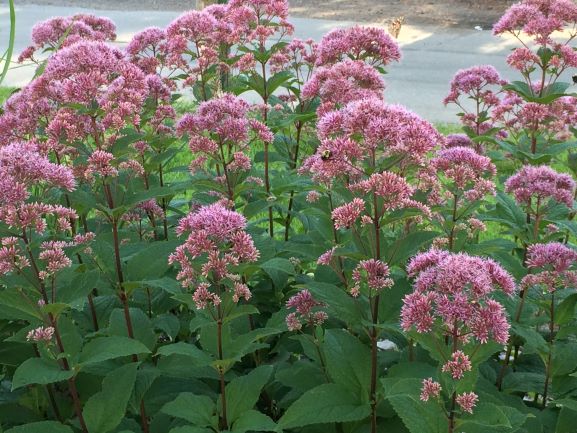Proven Rain Garden Plants for Nebraska

Rain gardens have been a landscape feature for a while now. This has helped us determine which plants are proving to do well in the bottom of rain gardens.
Rain gardens are shallow depressions located where they collect rainwater from a slope or downspout. Their purpose is to make the most of rainfall when received by soaking it in and reducing the amount of runoff during rain storms.
As with any garden, selecting the best plants for the site’s growing conditions is important for success. An added challenge with rain gardens is the bottom fills with water for 12 to 48 hours after rainfall and the soil tends to remain moist.
Here are some full sun plants proving to be good selections for the bottom of Nebraska rain gardens. These are plants that thrive in or tolerate inundation and wetter soils.
For shorter plants, try Carex, Siberian Iris, Chelone, Monarda, cardinal flower or hardy geranium. These plants range in height from one foot up to two and a half or three feet.
Carex (sedges) are proving to be the foundation of rain gardens. Many start growth before most ornamental grasses and have few issues with standing in water for 48 hours or less. And some tolerate drought in dry years.
A few favorite Carex are brown fox sedge (C. vulpinoidea), palm sedge (C. muskingumensis) and gray sedge (C. grayi). All three are native to North America. Know there are many other Carex to try.
Brown fox sedge has narrow grass-like blades and forms two foot clumps. Seed heads are short-lived and can reseed themselves. Gray sedge has attractive seed heads that remain on the plant into fall. The one-half inch wide grass-like leaves are semi-evergreen.
Palm sedge are yellowish green adding contrast to darker green plants and the foliage somewhat resembles palm fronds. It is a dense forming plant with yellow fall color and is best cut back over winter.
Siberian Iris (Iris sibirica) blooms in May only but the deep purple blooms are worth it, especially as not much else is blooming at that time. The foliage remains attractive all summer. They grow from rhizomes and will need dividing like all Iris. “Caesar’s Brother’ is a popular variety.
Chelone lyonii or turtlehead have proven their worth. The foliage remains attractive all summer and the plant has pink blooms from July into September. Plants spread slowly to fill in their garden space and shade out weeds. ‘Hot Lips’ remains as a popular variety.
Cardinal flower, Lobelia cardinalis, attracts hummingbirds and butterflies. It is a short-lived plant but the bright red flowers on spikes are a nice contrast and make this plant a worthy addition to rain gardens.
Hardy or cranesbill Geranium grows near the bottom as well as the sides and tops of rain gardens. It is a low growing, mounding plant. If you select the right cultivar, such as ‘Rozanne’, it blooms from early July until frost.
For taller plants, those ranging in size from 3 to 6 feet, use blue star Amsonia, bee balm, Virginia mountain-mint, Helenium, swamp milkweed or Joe-pye weed. Joe-pye weed is the photo at the beginning of this article.
Blue Star Amsonia blooms in May with light blue flowers on upright plants. The narrow glossy leaves remain attractive and make a nice backdrop for other blooms. Fall color is bright yellow.
Bee balm, Monarda didyma, blooms June into August. Be sure to select varieties resistant to powdery mildew such Grape Gumball or Raspberry Wine. Marshall and Petite Delight are good selections too. Bee balm is a magnet for butterflies and native bees.
Virginia mountain-mint, Pycnanthemum virginatum, is not a true mint and does not spread. And it’s native to wet meadows and near streams, not mountains. It does have a mint aroma when crushed though and the clusters of small, white flowers attract native bees from mid to late summer.
Helenium autumnale can grow up to five feet tall and bloom from August to October. Plants can be cut back in early June to control height and promote more branching with more flowers. Flower color ranges from yellow to orange and red depending on which variety you select.
Swamp milkweed, Asclepias incarnata, not only does well in the moist bottom of rain gardens but helps Monarch butterflies too. Plants usually grow three to four feet tall and produce clusters of pink flowers from August through September. Bright orange, sap-sucking oleander aphids do love this plant.
Joe-pye weed, Eupatorium maculatum, is a standby in almost every rain garden I’ve seen. This late summer blooming plant can reach six feet or taller. Most gardeners plant “Little Joe’ which grows up to three feet tall. When in bloom, the flowers are buzzing with bees, butterflies and other beneficial insects.
For other rain garden plants to try, check out the Nebraska Bioretention and Rain Garden Plants Guide at https://go.unl.edu/omvw.
And if you don’t have a rain garden yet, consider one. During drought years, rain gardens help make the most of what little rainfall there is by collecting and soaking it in.
This article was reviewed by Nicole Stoner
Sign up for updates from UNL Water
